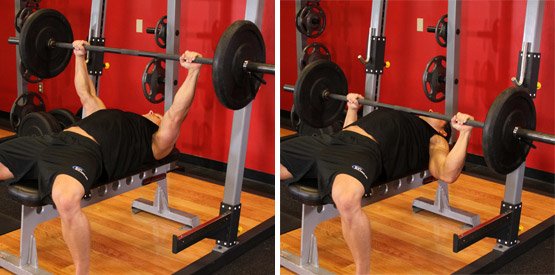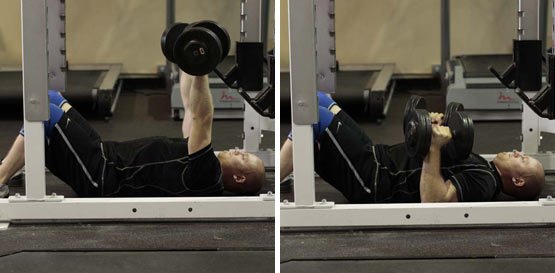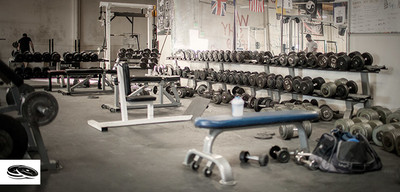If you have been stuck benching 250 lbs. and really want to get to 300 lbs. then reading this article will be the biggest step you take this year. Get ready to bench press 250, 300, 400, or more!

Barbell Bench Press
Quick Tips & Questions
Tips To Keep In Mind
- Keep your elbows tucked in to your side and use your strong triceps to help the lift. The Bench Press Strength! manual contains the appropriate volume and intensity of triceps work to prepare your arms.
- Use your whole body in the lift. Push against the floor with your feet. Keep your upper back muscles tensed and keep the upper back on the bench for stability.
- Push the bar straight up to reduce the movement distance.
- Practice your technique! Heavy lifting is a combination of skill and muscular work, so you learn how to perform the movement most efficiently.
- Identify your weaknesses so that you can train appropriately.
Questions To Ask Yourself
- What are your weaknesses in the bench press? Liftoff? Lockout?
- What are your strengths in your lifts?
- What are your specific goals for the bench press?
- What is your training schedule? Detail each workout day.
- Have you had any injuries?
- What training program has given you the best results in the past?
Bench Press Tips From The Experts
The first step to improving your bench (even before designing your program) is figuring out what the heck is stopping you from benching more weight.
What Is Your Weak Area In The Exercise?
If You Fail At The Bottom:
If you just can't get the weight off your chest (but would have no problem with the lockout), you need to become more explosive in the start of the movement. Dave Tate recommends you incorporate explosive pressing. This is described later in this article as Dynamic Effort" training.
If You Can't Complete The Lockout:
If so, then your triceps strength (or lack of it) may limit your success. Use a combination of heavy close-grip presses and triceps extensions to build the necessary triceps strength.
Pick the weak spot in your bench and make it a priority in training.
Other Factors
In addition to determining your weaknesses in the bench, here are a couple of other factors you can modify that will help you add plates to your press.
The Importance Of Body Position When You Bench:
If you want to bench heavy, you have to turn bench pressing from a bodybuilding exercise into a skill. That means you have to practice the form that allows you to lift the heaviest weight. Dave Tate insists on keeping your upper body tight and keeping your upper back and lats contracted.
Review each rep afterward and use this feedback to improve each future rep. According to Tate, you should "stay tight, keep the elbows tucked, drive your heels into the floor and shove your body away from the bar as you press".
Practice your technique. Treat strength development like any skill development. Perfect practice makes perfect presses.
You have to do it over and over again to find your best method of benching.
Strengthen Your Upper Back
You don't just need a strong chest and triceps to bench big. You also need a strong upper back to keep your body tight and stable. Concentrate on barbell rowing, seated rowing, and pull-ups (or pulldowns) to build a big strong back.
In addition to stability, this will also go a long way in keeping your shoulders healthy (and your upper back looking nice and thick).
Bench Press Strength Techniques
Maximal Effort Training
This type of training refers to the sessions where you lift as much weight as you possibly can for a specific number of repetitions.
For example, a 5 RM maximal effort session would require you to work up the best weight that you can lift for 5 repetitions with good form.
Dynamic Effort Training
Dave Tate recommends devoting one day per week to "dynamic effort" training. Dynamic effort training is designed to increase explosiveness. The foundation of a dynamic effort workout is opposite to a traditional workout.
Because the focus of a dynamic exercise is to move the weight as fast as possible, you will use much less weight. In addition, rather than performing a small number of sets and many repetitions, you will perform a larger number of sets with a smaller number of repetitions (i.e. 8 sets of 3 repetitions for the bench press).
It is extremely important to push the bar with maximal force on each rep. Don't take it easy just because it is a lighter weight. Adding chains and bands (see below) helps increase the resistance at the top of the movement. You must press with maximal force to overcome the added resistance at the top of the movement. Tate describes dynamic effort training as, "compensatory acceleration" and that "it can help you break through sticking points".
The key to getting through a sticking point as Tate describes it is to, "train to accelerate through the sticking point". If you explode the bar up, you can break through your sticking point. When training with the dynamic effort, focus on bar speed. If the bar slows down from rep to rep, it means the weight is too heavy. Use a resistance that is ~50% of your estimated 1 RM bench for 8 sets of 3.
The Use Of Bands and Chains in Bench Press Training
Adding a chain or band increases the resistance at the top of the movement. For example, if you have 225 lbs. on the bar plus a 10 lb. chain on each side, you will bench press 225 lbs. off your chest but you will lockout 245 lbs. The chains must be attached to "unload" onto the floor when the bar is lowered.
The same principle applies to the bands. The bands are looped around both a secure object at ground level and the ends of the barbell. The bands then provide less resistance at the bottom of the movement.
Bench Press Exercise Descriptions
Remember to always have a spotter for heavy bench pressing and for the lift-off. Your spotter will help you get the bar off the rack and out to the start position. You will also need them to make sure that you complete every repetition in your set.
Bench Press
- Keep your feet flat on the floor, legs bent, and upper back flat against the bench.
- Grip the bar using a medium-width grip.
- Have your spotter help you take the bar from the rack.
- Keeping your elbows close to your sides, lower the bar straight down to the bottom of your chest.
- Pause briefly and then press the bar back up above the chest in a straight line.
Dynamic Bench Press

Bench Press with Chains
- Attach the chains or bands to the ends of the bar as required. Make sure to anchor the bands under the rack or with very heavy dumbbells.
- Keep your feet flat on the floor, legs bent, and upper back flat against the bench.
- For the first 3 sets, grip the bar using a medium-width grip. Use a slightly wider grip for the next 3 sets, and a slightly narrower grip for the final 3 sets.
- Keeping your elbows close to your sides, lower the bar straight down to the bottom of your chest.
- Accelerate the bar up as quickly as possible. Perform all 3 reps as fast as you can.
Dumbbell Floor Press

Dumbbell Floor Press
- Lie on the floor and hold the dumbbells above your chest with your palms turned toward your feet.
- Lower the dumbbells until your upper arms contact the floor.
- Pause briefly and then press the dumbbells straight up above the chest.
- You can also hold the dumbbells with your palms turned towards your body (palms will face each other) to emphasize triceps and minimize shoulder stress.
A floor press strengthens the mid-point of your bench and demands a strong grip. It also removes the leg drive from the exercise and makes you work harder while forcing you to keep your body tight.
Do 2-3 sets of 6-8 reps. Start with no more than 75 percent of what you use in a normal flat bench dumbbell press.

